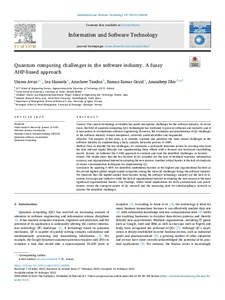Quantum computing challenges in the software industry. A fuzzy AHP-based approach
Dhir Amandeep; Tandon Anushree; Goyal Raman Kumar; Awan Usama; Hannola Lea
https://urn.fi/URN:NBN:fi-fe2022081154998
Tiivistelmä
Context
The current technology revolution has posed unexpected challenges for the software industry. In recent years, the field of quantum computing (QC) technologies has continued to grow in influence and maturity, and it is now poised to revolutionise software engineering. However, the evaluation and prioritisation of QC challenges in the software industry remain unexplored, relatively under-identified and fragmented.
Objective
The purpose of this study is to identify, examine and prioritise the most critical challenges in the software industry by implementing a fuzzy analytic hierarchy process (F-AHP).
Method
First, to identify the key challenges, we conducted a systematic literature review by drawing data from the four relevant digital libraries and supplementing these efforts with a forward and backward snowballing search. Second, we followed the F-AHP approach to evaluate and rank the identified challenges, or barriers.
Results
The results show that the key barriers to QC adoption are the lack of technical expertise, information accuracy and organisational interest in adopting the new process. Another critical barrier is the lack of standards of secure communication techniques for implementing QC.
Conclusion
By applying F-AHP, we identified institutional barriers as the highest and organisational barriers as the second highest global weight ranked categories among the main QC challenges facing the software industry. We observed that the highest-ranked local barriers facing the software technology industry are the lack of resources for design and initiative while the lack of organisational interest in adopting the new process is the most significant organisational barrier. Our findings, which entail implications for both academicians and practitioners, reveal the emergent nature of QC research and the increasing need for interdisciplinary research to address the identified challenges.
Kokoelmat
- Rinnakkaistallenteet [19207]
